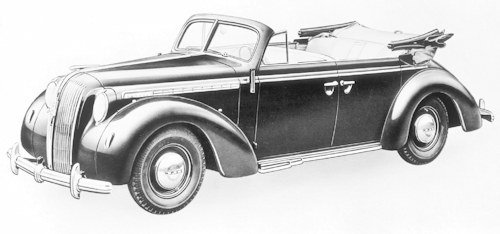Opel Admiral
 |
|
|
Production period: |
1937 to 1939 |
|
Class: |
Luxury car |
|
Body versions: |
Sedan, cabriolet |
|
Engines: |
Gasoline: 3.6 liters (55 kW) |
|
Length: |
5270 mm |
|
Width: |
1800 mm |
|
Height: |
1630 mm |
|
Wheelbase: |
3155 mm |
|
Curb weight: |
1605 kg |
|
Max speed: |
82 mph (132 kmh) |
The Opel Admiral was a luxury class car of the Adam Opel AG in the 1930s, which was built in its first version only from 1937 to 1939
History
The Admiral was the largest Opel made in the 1930s, and used a cruciform-braced chassis similar to that of the Super Six. As a new Opel top model, the Admiral was presented together with the smaller Super 6 in February 1937 at the 27th International Motorcycle and Motor Show (IAMA) in Berlin. The Admiral presented with his 75-horsepower engine. The engine was virtually the same as the Chevrolet SIX, but with a larger on the bore gave a capacity of 3.6 litres and for his time many special accessories for comparatively cheap 6500 Reichsmarks. The 3.6-Litre, .Engine, with overhead valves; bore 90 mm. ; stroke 95 -mm.cubic capacity 3,601 c.c.b.h.p. 79 at 3,200 r.p.m.5-point flexible engine mounting ; préssure feed lubrication ; Opel down-draught carburettor with inter-connected choke and throttle control and butterfly valve to prevent overchoking ; Bosch coil ignition ; aluminium silicon alloy pistons with steel strut and solid skirt.4-bearing crankshaft and harmonic balancer.
The cruciform frame and "Dubonnet" independent front-wheel suspension ; Opel synchron springing ; semi-elliptic rear springs ; hydraulic shock absorbers front and rear ; stabiliser bar for braking four-wheel hydraulic brakes ; braking surface 194 square inches ; tyres 6.50 X • 16.
Factory bodies on the Admiral chassis were Only two, a four-door saloon and cabriolet. However, a number of firms built custom bodies, including Glaser whose two-door cabriolet factory, the car was available as a closed, four-door sedan, as a Pullman sedan and as a four-door convertible. In contrast to the captain with self-supporting body, the Admiral was suitable with its separation of chassis and body for custom-made special bodies, such as two-seater convertibles, which produced, among other things, the bodywork pullman-limousine by Hebmuller and Gläser-Karosserie. The Opel top model brought it in the only unrestricted year of production in the automotive luxury class.
Featured Equipment for the Admiral "Cabriolet".Double mechanical windscreen wiper ; combination tail and stop lamp ; dome lamp ; traffcators ; cigar lighter ; automatic entrance lamps on all doors ;clock; speedometer ; oil pressure and fuel gauge ; thermometer for radiator water ; light switch ; switch for instrument lights ; screenwiper switch ; trafficator control lamp ; high beam indicator ; glove pocket with doör ash tray; no-draught ventilation ; top cowl ventilation ; steering and ignition lock ; foot dimmer switch ; two sun Visors ; oval rearview mirror ; folding arm rest ; mascot ; front and rear bumpers ; spare wheel and tyre ; complete set of tools.
The Admiral was considered a representative, comfortable and fast touring car, which was designed for use on the new imperial motorways: With a consumption of about 18 l / 100 km could be driven almost 400 km.
The production ended already in October 1939, since the engines were needed for the three-ton Opel Blitz 3,6 due to the war. Numerous Opel "Admiral" were requisitioned shortly before the war began by the Wehrmacht to be used as staff car for generals and senior officers. Some vehicles were also converted to makeshift ambulance and received from the B-pillar closed box body.
After the war, there were only a few vehicles ready to be used. But there were also new vehicles that were kept in a hiding place by the owners during the war. Rather isolated was an "Admiral" equipped with a wood gas system. The boiler was installed vertically standing in the rear. The US occupation forces used some captured cars.
Top model at Opel was from now on the captain, whose production was resumed in almost unchanged form in 1948. The Russelsheim production of 3.6-liter engines could not be used for a remake of the "Admiral" after the war, as the production of engines with more than 1.5 liters capacity of the occupying powers was still banned for some years. It was not until 1964 that Opel launched a completely new "Admiral" - 25 years after the first model with this name was discontinued.
In total, only 6404 vehicles of the "pre-war" admiral were built which 590 were chassis supplied to coachbuilders. As a result of this small number of pieces and since almost all vehicles came to the war effort and were destroyed in the context of this, this type is today a very rare vintage car.

Technical
-
Opel Admiral Technical specifications (1937-1939)
Engine:
Six - cylinder inline engine,
crankshaft mounted four timesDisplacement:
3626 cc
Bore × stroke:
90 × 95 mm
Power:
75 hp (55 kW) at 3200 rpm
Valve control:
(OHV) overhead valves, bumpers, rocker arms, side camshaft with spur gear
Cooling System:
Liquid cooling with pump and fan
Front suspension:
Independent suspension with Opel synchronized suspension: drawn, single longitudinal swing arm with a horizontal spring / damper arrangement (Dubonnet suspension)
Rear suspension:
Rigid axle with leaf springs and stabilizer
Chassis / Structure:
Box frame with X-Traverse
construction in mixed construction (steel and wood) as a four-door sedan and convertible, tank capacity 70 litersWheel size:
6.50-16 "
Dimensions L × W × H:
5270 × 1800 × 1630 mm
Curb weight (without driver):
about 1605 kg
maximum speed:
132 km / h
Price:
6500 RM (sedan); 7000 RM (Cabriolet)
